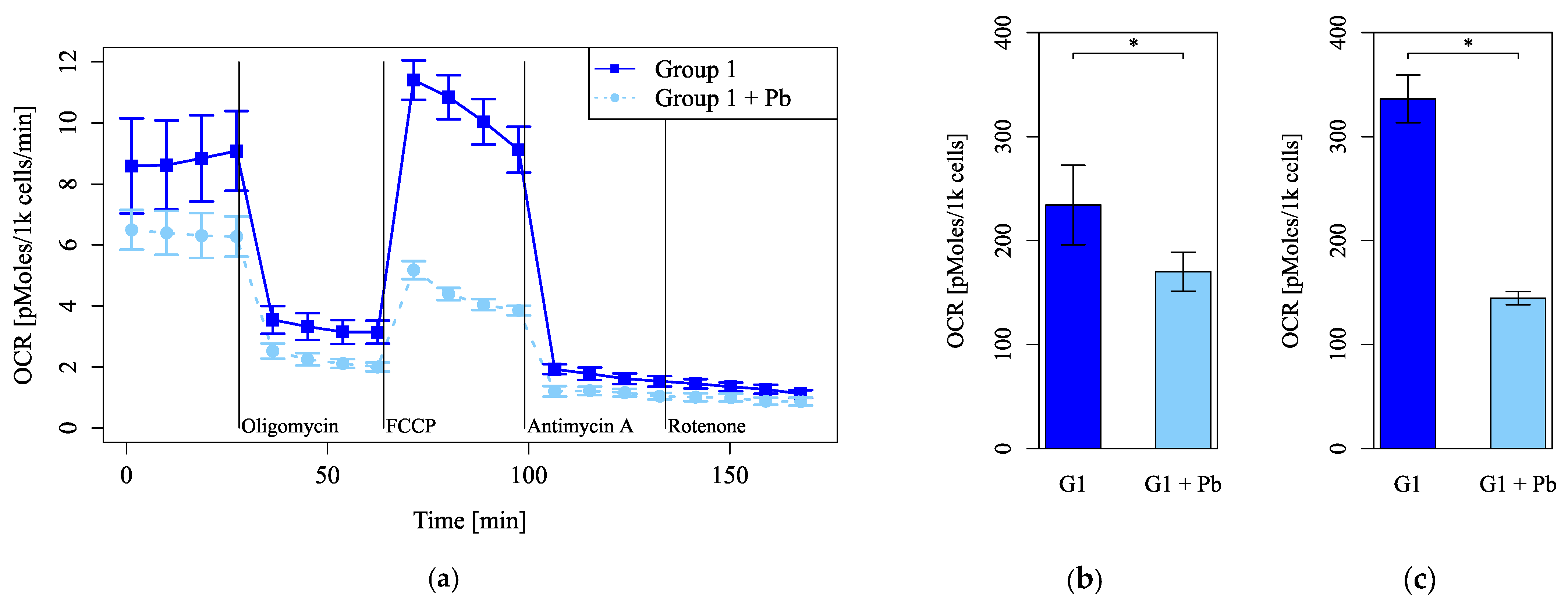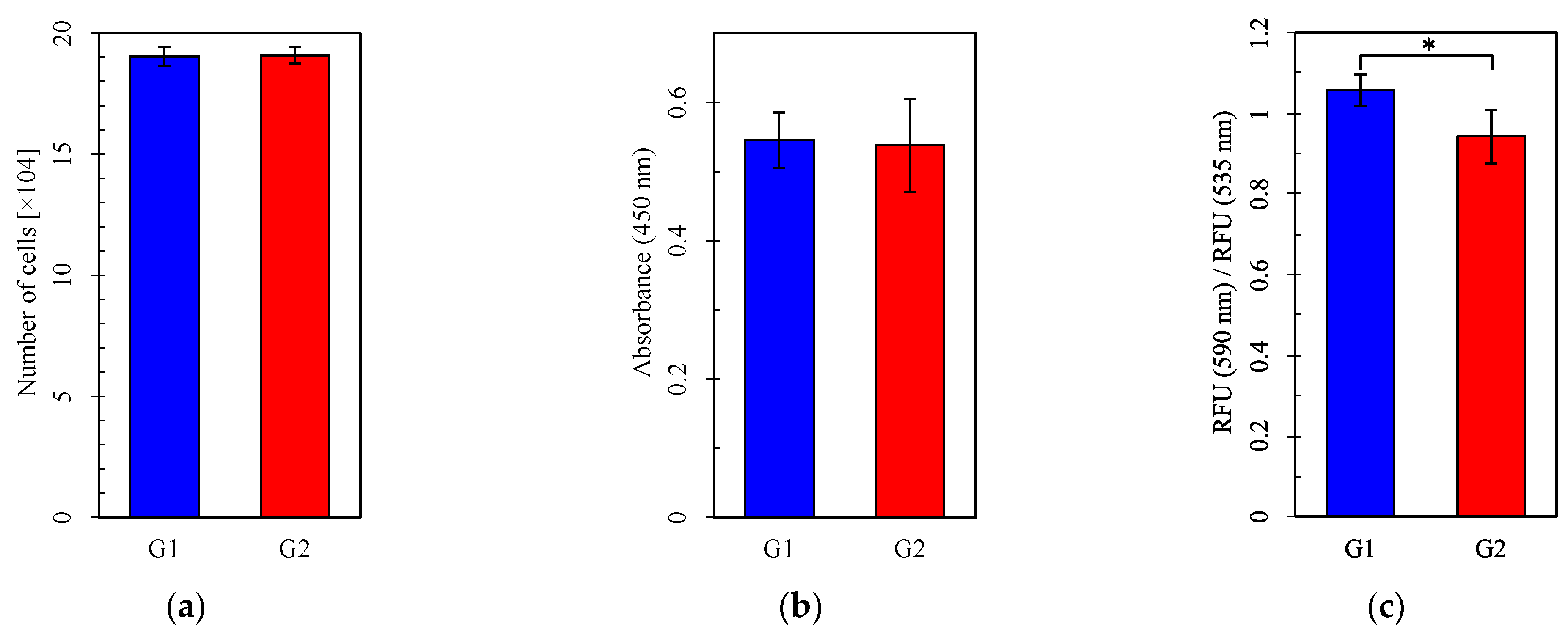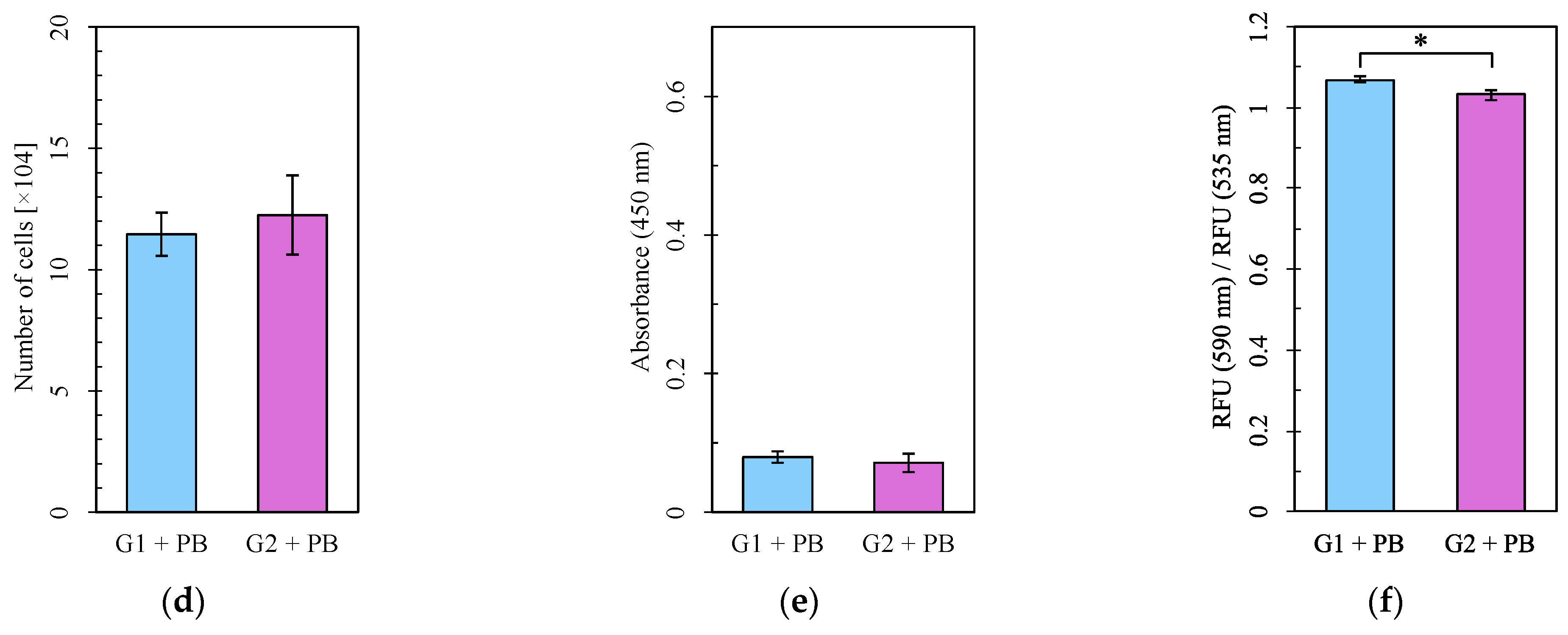The Effects of Circadian Rhythm on Lead-Induced Toxicity in the DBC1.2 Olfactory Dark Basal Cell Line
Abstract
1. Introduction
2. Materials and Methods
2.1. Cell Cultures
2.2. Pb Exposure
2.3. Cell Viability Assay and Population Analysis
2.4. Quantitative PCR Analysis
2.5. Extracellular Flux Analysis
2.6. Mitochondrial Membrane Potential (MMP) Assay
2.7. Experimental Design
2.8. Statistical Analysis
3. Results
3.1. Circadian Rhythm Was Reset After Dexamethasone Shock
3.2. Pb-Induced Mitochondrial Dysfunction
3.3. Pb-Induced Changes in Mitochondrial Function Depended on Circadian Rhythm
4. Discussion
5. Conclusions
Author Contributions
Funding
Institutional Review Board Statement
Informed Consent Statement
Data Availability Statement
Acknowledgments
Conflicts of Interest
Appendix A
Appendix B
References
- Patke, A.; Young, M.W.; Axelrod, S. Molecular Mechanisms and Physiological Importance of Circadian Rhythms. Nat. Rev. Mol. Cell Biol. 2020, 21, 67–84. [Google Scholar] [CrossRef] [PubMed]
- Meyer, N.; Harvey, A.G.; Lockley, S.W.; Dijk, D.J. Circadian Rhythms and Disorders of the Timing of Sleep. Lancet 2022, 400, 1061–1078. [Google Scholar] [CrossRef] [PubMed]
- Schrader, L.A.; Ronnekleiv-Kelly, S.M.; Hogenesch, J.B.; Bradfield, C.A.; Malecki, K.M.C. Circadian Disruption, Clock Genes, and Metabolic Health. J. Clin. Investig. 2024, 134, e170998. [Google Scholar] [CrossRef]
- Doty, R.L. Olfactory Dysfunction in Neurodegenerative Diseases: Is There a Common Pathological Substrate? Lancet Neurol. 2017, 16, 478–488. [Google Scholar] [CrossRef]
- McLaren, A.M.R.; Kawaja, M.D. Olfactory Dysfunction and Alzheimer’s Disease: A Review. J. Alzheimer’s Dis. 2024, 99, 811–827. [Google Scholar] [CrossRef] [PubMed]
- Bochniak, K.; Soszyński, M.; Madetko-Alster, N.; Alster, P. Current Perspectives on Olfactory Loss in Atypical Parkinsonisms—A Review Article. Biomedicines 2024, 12, 2257. [Google Scholar] [CrossRef]
- Liu, Z.Y.; Vaira, L.A.; Boscolo-Rizzo, P.; Walker, A.; Hopkins, C. Post-Viral Olfactory Loss and Parosmia. BMJ Med. 2023, 2, e000382. [Google Scholar] [CrossRef] [PubMed]
- Nassan, M.; Videnovic, A. Circadian Rhythms in Neurodegenerative Disorders. Nat. Rev. Neurol. 2022, 18, 7–24. [Google Scholar] [CrossRef]
- Canever, J.B.; Queiroz, L.Y.; Soares, E.S.; de Avelar, N.C.P.; Cimarosti, H.I. Circadian Rhythm Alterations Affecting the Pathology of Neurodegenerative Diseases. J. Neurochem. 2023, 168, 1475–1489. [Google Scholar] [CrossRef] [PubMed]
- Han, B.; Kamogashira, T.; Kikuta, S.; Yamasoba, T. Endoplasmic Reticulum Stress Associated with Lead (Pb)-Induced Olfactory Epithelium Toxicity in an Olfactory Dark Basal Cell Line. FEBS Open Bio 2023, 13, 2162–2171. [Google Scholar] [CrossRef] [PubMed]
- Satoh, M.; Takeuchi, M. Induction of NCAM Expression in Mouse Olfactory Keratin-Positive Basal Cells in Vitro. Brain Res. Dev. Brain Res. 1995, 87, 111–119. [Google Scholar] [CrossRef] [PubMed]
- Liu, C.-M.; Ma, J.-Q.; Sun, Y.-Z. Puerarin Protects the Rat Liver Against Oxidative Stress-Mediated DNA Damage and Apoptosis Induced by Lead. Exp. Toxicol. Pathol. 2012, 64, 575–582. [Google Scholar] [CrossRef] [PubMed]
- Han, Q.; Zhang, W.; Guo, J.; Zhu, Q.; Chen, H.; Xia, Y.; Zhu, G. Mitochondrion: A Sensitive Target for Pb Exposure. J. Toxicol. Sci. 2021, 46, 345–358. [Google Scholar] [CrossRef]
- Gao, K.; Zhang, C.; Tian, Y.; Naeem, S.; Zhang, Y.; Qi, Y. The Role of Endoplasmic Reticulum Stress in Lead (Pb)-Induced Mitophagy of HEK293 Cells. Toxicol. Ind. Health 2020, 36, 1002–1009. [Google Scholar] [CrossRef]
- Gao, L.; Chen, H.; Li, C.; Xiao, Y.; Yang, D.; Zhang, M.; Zhou, D.; Liu, W.; Wang, A.; Jin, Y. ER Stress Activation Impairs the Expression of Circadian Clock and Clock-Controlled Genes in NIH3T3 Cells via an ATF4-Dependent Mechanism. Cell. Signal. 2019, 57, 89–101. [Google Scholar] [CrossRef]
- Liang, W.; Qi, W.; Geng, Y.; Wang, L.; Zhao, J.; Zhu, K.; Wu, G.; Zhang, Z.; Pan, H.; Qian, L.; et al. Necroptosis Activates UPR Sensors Without Disrupting Their Binding with GRP78. Proc. Natl. Acad. Sci. USA 2021, 118, e2110476118. [Google Scholar] [CrossRef]
- Rabinovich-Nikitin, I.; Lieberman, B.; Martino, T.A.; Kirshenbaum, L.A. Circadian-Regulated Cell Death in Cardiovascular Diseases. Circulation 2019, 139, 965–980. [Google Scholar] [CrossRef] [PubMed]
- Chen, X.; Shi, C.; He, M.; Xiong, S.; Xia, X. Endoplasmic Reticulum Stress: Molecular Mechanism and Therapeutic Targets. Signal Transduct. Target. Ther. 2023, 8, 352. [Google Scholar] [CrossRef] [PubMed]
- Marshall, K.D.; Baines, C.P. Necroptosis: Is There a Role for Mitochondria? Front. Physiol. 2014, 5, 323. [Google Scholar] [CrossRef] [PubMed]
- Drew, C.A.; Spence, I.; Johnston, G.A.R. Effects of Lead Salts on the Uptake, Release, and Binding of Γ-Aminobutyric Acid: The Importance of Buffer Composition. J. Neurochem. 1989, 52, 433–440. [Google Scholar] [CrossRef] [PubMed]
- Schneider, C.A.; Rasband, W.S.; Eliceiri, K.W. NIH Image to ImageJ: 25 Years of Image Analysis. Nat. Method. 2012, 9, 671–675. [Google Scholar] [CrossRef] [PubMed]
- Rueden, C.T.; Schindelin, J.; Hiner, M.C.; DeZonia, B.E.; Walter, A.E.; Arena, E.T.; Eliceiri, K.W. ImageJ2: ImageJ for the Next Generation of Scientific Image Data. BMC Bioinform. 2017, 18, 529. [Google Scholar] [CrossRef] [PubMed]
- Schindelin, J.; Arganda-Carreras, I.; Frise, E.; Kaynig, V.; Longair, M.; Pietzsch, T.; Preibisch, S.; Rueden, C.; Saalfeld, S.; Schmid, B.; et al. Fiji: An Open-Source Platform for Biological-Image Analysis. Nat. Method. 2012, 9, 676–682. [Google Scholar] [CrossRef] [PubMed]
- Preitner, N.; Damiola, F.; Lopez-Molina, L.; Zakany, J.; Duboule, D.; Albrecht, U.; Schibler, U. The Orphan Nuclear Receptor REV-ERBalpha Controls Circadian Transcription Within the Positive Limb of the Mammalian Circadian Oscillator. Cell 2002, 110, 251–260. [Google Scholar] [CrossRef]
- Honma, A.; Yamada, Y.; Nakamaru, Y.; Fukuda, S.; Honma, K.I.; Honma, S. Glucocorticoids Reset the Nasal Circadian Clock in Mice. Endocrinology 2015, 156, 4302–4311. [Google Scholar] [CrossRef]
- R Core Team. R: A Language and Environment for Statistical Computing; R Foundation for Statistical Computing: Vienna, Austria, 2024. [Google Scholar]
- Sarlus, H.; Fontana, J.M.; Tserga, E.; Meltser, I.; Cederroth, C.R.; Canlon, B. Circadian Integration of Inflammation and Glucocorticoid Actions: Implications for the Cochlea. Hear. Res. 2019, 377, 53–60. [Google Scholar] [CrossRef] [PubMed]
- Huang, J.; Lu, C.; Chen, S.; Hua, L.; Qian, R. Postnatal Ontogenesis of Clock Genes in Mouse Suprachiasmatic Nucleus and Heart. Lipids Health Dis. 2010, 9, 22. [Google Scholar] [CrossRef] [PubMed]
- Balsalobre, A.; Brown, S.A.; Marcacci, L.; Tronche, F.; Kellendonk, C.; Reichardt, H.M.; Schütz, G.; Schibler, U. Resetting of Circadian Time in Peripheral Tissues by Glucocorticoid Signaling. Science 2000, 289, 2344–2347. [Google Scholar] [CrossRef]
- So, A.Y.-L.; Bernal, T.U.; Pillsbury, M.L.; Yamamoto, K.R.; Feldman, B.J. Glucocorticoid Regulation of the Circadian Clock Modulates Glucose Homeostasis. Proc. Natl. Acad. Sci. USA 2009, 106, 17582–17587. [Google Scholar] [CrossRef] [PubMed]
- Beta, R.A.A.; Arsenopoulou, Z.V.; Kanoura, A.; Dalkidis, D.; Avraamidou, R.; Balatsos, N.A.A. Core Clock Regulators in Dexamethasone-Treated HEK 293T Cells at 4 h Intervals. BMC Res. Notes 2022, 15, 23. [Google Scholar] [CrossRef] [PubMed]
- Oster, H.; Challet, E.; Ott, V.; Arvat, E.; de Kloet, E.R.; Dijk, D.J.; Lightman, S.; Vgontzas, A.; Van Cauter, E. The Functional and Clinical Significance of the 24-Hour Rhythm of Circulating Glucocorticoids. Endocr. Rev. 2017, 38, 3–45. [Google Scholar] [CrossRef] [PubMed]
- Yang, Z.; Kim, H.; Ali, A.; Zheng, Z.; Zhang, K. Interaction Between Stress Responses and Circadian Metabolism in Metabolic Disease. Liver Res. 2017, 1, 156–162. [Google Scholar] [CrossRef]
- Ferraz-Bannitz, R.; Beraldo, R.A.; Coelho, P.O.; Moreira, A.C.; Castro, M.; Foss-Freitas, M.C. Circadian Misalignment Induced by Chronic Night Shift Work Promotes Endoplasmic Reticulum Stress Activation Impacting Directly on Human Metabolism. Biology 2021, 10, 197. [Google Scholar] [CrossRef] [PubMed]
- Han, Y.; Shon, J.; Kwon, S.Y.; Park, Y.J. Effects of Dietary Protein Intake Levels on Peripheral Circadian Rhythm in Mice. Int. J. Mol. Sci. 2024, 25, 7373. [Google Scholar] [CrossRef]
- Peek, C.B.; Affinati, A.H.; Ramsey, K.M.; Kuo, H.-Y.; Yu, W.; Sena, L.A.; Ilkayeva, O.; Marcheva, B.; Kobayashi, Y.; Omura, C.; et al. Circadian Clock NAD+ Cycle Drives Mitochondrial Oxidative Metabolism in Mice. Science 2013, 342, 1243417. [Google Scholar] [CrossRef]
- Cela, O.; Scrima, R.; Pazienza, V.; Merla, G.; Benegiamo, G.; Augello, B.; Fugetto, S.; Menga, M.; Rubino, R.; Fuhr, L.; et al. Clock Genes-Dependent Acetylation of Complex I Sets Rhythmic Activity of Mitochondrial OxPhos. Biochim. Biophys. Acta Mol. Cell Res. 2016, 1863, 596–606. [Google Scholar] [CrossRef]
- De Goede, P.; Wefers, J.; Brombacher, E.C.; Schrauwen, P.; Kalsbeek, A. Circadian Rhythms in Mitochondrial Respiration. J. Mol. Endocrinol. 2018, 60, R115–R130. [Google Scholar] [CrossRef] [PubMed]
- Lee, J.H.; Sancar, A. Regulation of Apoptosis by the Circadian Clock through NF-ΚB Signaling. Proc. Natl. Acad. Sci. USA 2011, 108, 12036–12041. [Google Scholar] [CrossRef] [PubMed]
- Wang, F.; Li, C.; Yongluo; Chen, L. The Circadian Gene Clock Plays an Important Role in Cell Apoptosis and the DNA Damage Response In Vitro. Technol. Cancer Res. Treat. 2016, 15, 480–486. [Google Scholar] [CrossRef]
- Ertosun, M.G.; Kocak, G.; Ozes, O.N. The Regulation of Circadian Clock by Tumor Necrosis Factor Alpha. Cytokine Growth Factor Rev. 2019, 46, 10–16. [Google Scholar] [CrossRef] [PubMed]
- Pagel, R.; Bär, F.; Schröder, T.; Sünderhauf, A.; Künstner, A.; Ibrahim, S.M.; Autenrieth, S.E.; Kalies, K.; König, P.; Tsang, A.H.; et al. Circadian Rhythm Disruption Impairs Tissue Homeostasis and Exacerbates Chronic Inflammation in the Intestine. FASEB J. 2017, 31, 4707–4719. [Google Scholar] [CrossRef]
- Hoogstraten, C.A.; Smeitink, J.A.M.; Russel, F.G.M.; Schirris, T.J.J. Dissecting Drug-Induced Cytotoxicity and Metabolic Dysfunction in Conditionally Immortalized Human Proximal Tubule Cells. Front. Toxicol. 2022, 4, 842396. [Google Scholar] [CrossRef] [PubMed]
- Puig, L.S.; Valera-Alberni, M.; Cantó, C.; Pillon, N.J. Circadian Rhythms and Mitochondria: Connecting the Dots. Front. Genet. 2018, 9, 452. [Google Scholar]
- Neufeld-Cohen, A.; Robles, M.S.; Aviram, R.; Manella, G.; Adamovich, Y.; Ladeuix, B.; Nir, D.; Rousso-Noori, L.; Kuperman, Y.; Golik, M.; et al. Circadian Control of Oscillations in Mitochondrial Rate-Limiting Enzymes and Nutrient Utilization by PERIOD Proteins. Proc. Natl. Acad. Sci. USA 2016, 113, E1673–E1682. [Google Scholar] [CrossRef] [PubMed]
- Kohsaka, A.; Das, P.; Hashimoto, I.; Nakao, T.; Deguchi, Y.; Gouraud, S.S.; Waki, H.; Muragaki, Y.; Maeda, M. The Circadian Clock Maintains Cardiac Function by Regulating Mitochondrial Metabolism in Mice. PLoS ONE 2014, 9, e112811. [Google Scholar] [CrossRef] [PubMed]
- Amiama-Roig, A.; Verdugo-Sivianes, E.M.; Carnero, A.; Blanco, J.R. Chronotherapy: Circadian Rhythms and Their Influence in Cancer Therapy. Cancers 2022, 14, 5071. [Google Scholar] [CrossRef] [PubMed]
- Abe, Y.; Sakairi, T.; Beeson, C.; Kopp, J.B. TGF-Β1 Stimulates Mitochondrial Oxidative Phosphorylation and Generation of Reactive Oxygen Species in Cultured Mouse Podocytes, Mediated in Part by the MTOR Pathway. Am. J. Physiol. Ren. Physiol. 2013, 305, F1477–F1490. [Google Scholar] [CrossRef] [PubMed]
- Schuchmann, S.; Buchheim, K.; Heinemann, U.; Hosten, N.; Buttgereit, F. Oxygen Consumption and Mitochondrial Membrane Potential Indicate Developmental Adaptation in Energy Metabolism of Rat Cortical Neurons. Eur. J. Neurosci. 2005, 21, 2721–2732. [Google Scholar] [CrossRef] [PubMed]
- Rolfe, D.F.S.; Newman, J.M.B.; Buckingham, J.A.; Clark, M.G.; Brand, M.D. Contribution of Mitochondrial Proton Leak to Respiration Rate in Working Skeletal Muscle and Liver and to SMR. Am. J. Physiol. Cell Physiol. 1999, 276, C692–C699. [Google Scholar] [CrossRef]
- Nishio, K.; Konno, N.; Arata, Y.; Ueda, R.; Iijima, K.; Iwata, T.; Katagiri, T. Oxygen Consumption and Mitochondrial Membrane Potential in Postischemic Myocardium. In The Ischemic Heart; Springer: Boston, MA, USA, 2007; pp. 125–135. [Google Scholar]
- Kowaltowski, A.J.; Abdulkader, F. How and When to Measure Mitochondrial Inner Membrane Potentials. Biophys. J. 2024, 123, 4150–4157. [Google Scholar] [CrossRef] [PubMed]
- Jin, Z.; Ji, Y.; Su, W.; Zhou, L.; Wu, X.; Gao, L.; Guo, J.; Liu, Y.; Zhang, Y.; Wen, X.; et al. The Role of Circadian Clock-Controlled Mitochondrial Dynamics in Diabetic Cardiomyopathy. Front. Immunol. 2023, 14, 1142512. [Google Scholar] [CrossRef] [PubMed]
- Isobe, Y.; Hida, H.; Nishino, H. Circadian Rhythm of Metabolic Oscillation in Suprachiasmatic Nucleus Depends on the Mitochondrial Oxidation State, Reflected by Cytochrome C Oxidase and Lactate Dehydrogenase. J. Neurosci. Res. 2011, 89, 929–935. [Google Scholar] [CrossRef]







Disclaimer/Publisher’s Note: The statements, opinions and data contained in all publications are solely those of the individual author(s) and contributor(s) and not of MDPI and/or the editor(s). MDPI and/or the editor(s) disclaim responsibility for any injury to people or property resulting from any ideas, methods, instructions or products referred to in the content. |
© 2025 by the authors. Licensee MDPI, Basel, Switzerland. This article is an open access article distributed under the terms and conditions of the Creative Commons Attribution (CC BY) license (https://creativecommons.org/licenses/by/4.0/).
Share and Cite
Kamogashira, T.; Kikuta, S.; Yamasoba, T. The Effects of Circadian Rhythm on Lead-Induced Toxicity in the DBC1.2 Olfactory Dark Basal Cell Line. Cells 2025, 14, 81. https://doi.org/10.3390/cells14020081
Kamogashira T, Kikuta S, Yamasoba T. The Effects of Circadian Rhythm on Lead-Induced Toxicity in the DBC1.2 Olfactory Dark Basal Cell Line. Cells. 2025; 14(2):81. https://doi.org/10.3390/cells14020081
Chicago/Turabian StyleKamogashira, Teru, Shu Kikuta, and Tatsuya Yamasoba. 2025. "The Effects of Circadian Rhythm on Lead-Induced Toxicity in the DBC1.2 Olfactory Dark Basal Cell Line" Cells 14, no. 2: 81. https://doi.org/10.3390/cells14020081
APA StyleKamogashira, T., Kikuta, S., & Yamasoba, T. (2025). The Effects of Circadian Rhythm on Lead-Induced Toxicity in the DBC1.2 Olfactory Dark Basal Cell Line. Cells, 14(2), 81. https://doi.org/10.3390/cells14020081






